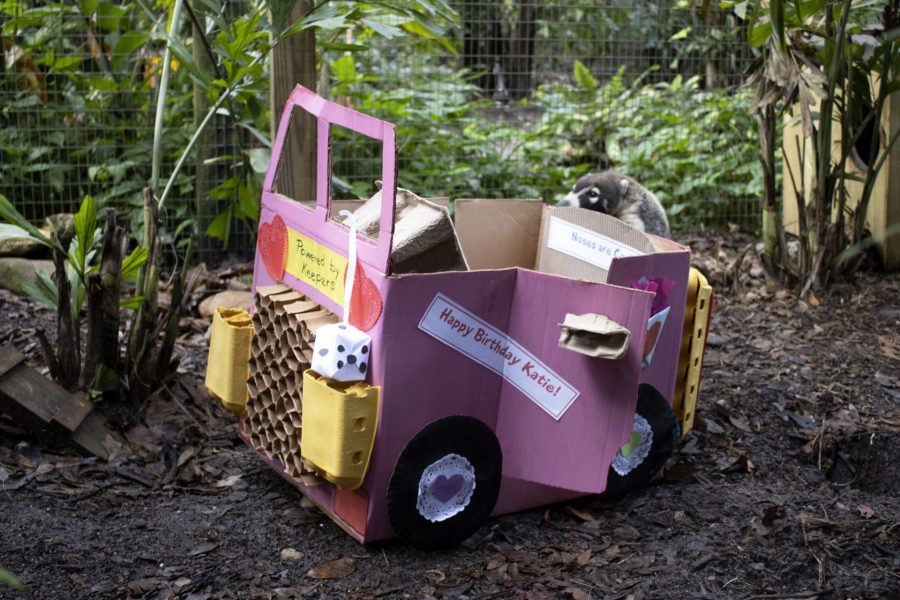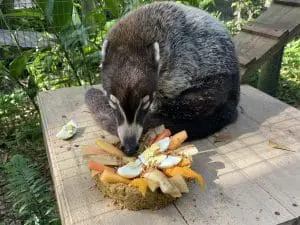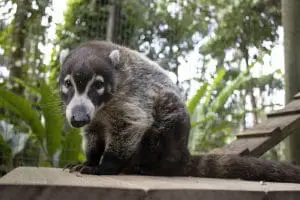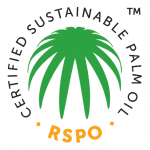

Katie the white-nosed coatimundi recently celebrated her 16th birthday with her very own car, made by our amazing volunteers!
Happy Sweet Sixteen to Katie, one of our white-nosed coatimundis! We’re proud to note that Katie is the third oldest coatimundi (also called coati) in an Association of Zoos and Aquariums (AZA) accredited facility.

Katie the coati also enjoyed a birthday cake with eggs, vegetables and mealworms!
Coatimundis are curious animals with an amazing sense of smell and sharp claws that help them tear through stumps and logs while looking for food. Here at the Zoo, we encourage Katie to act on this instinct by putting some of her favorite foods – crickets, mealworms, wax worms and super worms – in puzzle enrichments. She’s able to forage through items like wood shavings to work for her food.
Those same claws and sharp teeth make coatis difficult pets – especially paired with their high energy. Katie came to us in 2016 after living as a pet whose caretaker passed away. His family wasn’t sure how to care for this species.
“Virtually their entire life is built around searching for food and then getting to it,” said Zach Marchetti, curator of animals. “Imagine your home: every cabinet, every pantry, every crumb would be a source of interest, and they will dig and chew their way to the source of the smells. Additionally, coatis require specialized diets and veterinary care. They are still wild animals.’
Coati’s life expectancy is about 7-8 years in the wild and about 14 years in human care, making Katie a geriatric Zoo resident. We regularly assess Katie’s quality of life and look into ways to make her more comfortable. Ramps make it easy for Katie to explore her habitat if she chooses. She has also been trained to enter a secure carrier to be easily taken to our animal hospital for exams.

Katie the white-nosed coatimundi recently celebrated her 16th birthday with her very own car, made by our volunteers!
Katie currently shares her habitat with 11-year-old coati Lupita, but this may change soon. Last year, three young coatis – one male and two females – joined our Zoo. We have started the slow process of introducing the two groups by letting them take turns in exploring each other’s spaces as well as allowing them to “howdy,” or meet, while separated through their mesh habitats. The next step is to let the groups share a space.
“The exact process will be dictated by animal behavior,” Zach said. “We may introduce all five at once, or we may introduce single individuals but as always, we will let animal behavior guide our process.”
The end goal is to mimic their natural social structure – as a lone male and a group of females. We hope this will increase the likelihood of successful breeding.
Our three young coatis came to us as new founders for the AZA’s White-Nosed Coati Species Survival Plan (SSP), which is managed by our director of animal programs, Lauren Hinson. The goal of the SSP is to keep healthy, genetically diverse populations of certain species in accredited facilities like our Zoo.

While white-nosed coatis are not endangered, two subspecies of coati are facing immediate threats. The western mountain and eastern mountain coatis are near-threatened and endangered, respectively. One of the greatest threats to this entire species is loss of habitat. In South American rainforests, where many of these subspecies reside, the loss of habitat usually happens from the clearing of forests for timber, mining or farming.
To help this species, we can be conscientious in our shopping by supporting sustainable products and companies. Recycling electronics means we need to pull fewer precious metals from the earth. Buying furniture that uses sustainably harvested wood is also important.

Look for this trademark to choose grocery store items that use sustainably produced palm oil.
One of the greatest threats to rainforest habitats worldwide, however, comes from the creation of palm oil plantations. Palm oil can be found in everything from peanut butter and ice cream to baby formula and lipstick.
The Roundtable on Sustainable Palm Oil is a nonprofit that works with stakeholders in the palm oil industry to create global standards in sustainably producing this product. Look for their trademark to choose grocery store items that use sustainably produced palm oil.
By choosing these items, we can help ensure that coatimundis, as well as other rainforest animals, have plenty of habitat in their natural range to call their own.
Brevard Zoo is an independent, not-for-profit organization that receives no recurring government funding for our operating costs. Your generous support enables us to continue to serve our community and continue our vital animal wellness, education and conservation programs.